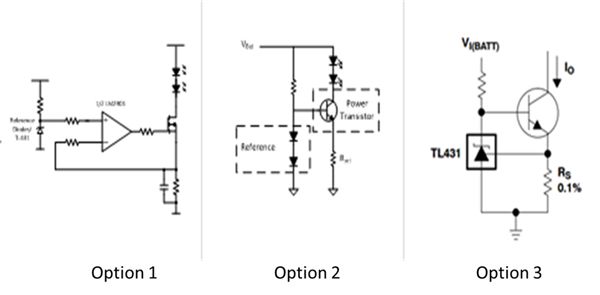Major automotive manufacturers are widely using light-emitting diodes (LEDs) in addition to traditional headlights, taillights, daytime running lights, parking lights, and turn signals to make their cars stand out from the market. At present, LEDs have appeared on the layout lamps, license plates, brand logos, welcome lights and ambient lights.
To drive these LEDs to light, the following issues must be considered:
1
Current accuracy, LED homogeneity will be significantly improved;
2
LED brightness changes require some kind of dimming function;
3
4
The diagnosis and protection and thermal protection of LED open/short circuit, because the safety issue has always been the focus of the car.
How to improve energy efficiency.
Traditionally, LEDs are driven by discrete solutions. Figure 1 shows three typical scenarios: an op amp (scheme 1), a power supply directly connected to the car battery (scheme 2), or a bipolar configuration of some shunting rules (scheme 3).

Figure 1: Typical discrete solution for driving LEDs
Let us first take a look at scheme 1, an operational amplifier driven from the low side. With op amps, relatively high accuracy (<10%) can be achieved and LEDs can be dimmed. However, with this solution, it is difficult to diagnose the open and short circuit of the LED. In addition, the difference between input and output voltages up to 1 volt is not very energy efficient.
Option 2 is also very popular. It consists of a diode and an NPN (n-channel p-channel n-channel) transistor. The solution is not only simple and cost-effective, but its accuracy is only about 20%. This index is far from enough. Because its input and output voltage difference is as high as 1.2 volts, its energy efficiency is even lower than that of scheme 1. In addition, it is impossible to diagnose the open and short circuit of the LED, and there is no pulse width modulation (PWM) dimming function. This solution is too late for today's design.
Option 3 is very popular (<5%) in applications that require extremely high output accuracy. Its input and output differential pressure is extremely high, reaching 3 volts. This solution may not be able to implement diagnostics or pulse width modulation dimming; therefore, the scope of use of this solution is narrower and the price paid is greater.
Admittedly, each solution has its own advantages and disadvantages, but compared to discrete solutions, the lower-cost overall solution not only reduces the number of system-level components, but also significantly improves current accuracy and reliability. The TPS9261x-Q1 series shown in Figure 2 is designed specifically for this purpose.

Figure 2: TPS9261x-Q1 Simplified Schematic
The TPS92610-Q1 device is a single-channel, high-side LED driver driven by a car battery. It is a simple and elegant solution that provides constant current for a single LED string with full LED diagnostics. With a precision of up to 7%, it can meet the needs of most applications.
The TPS9261x-Q1 has a variety of different package options, from small-outline transistor (SOT)-23, MSOP-8 to thermally enhanced thin small outline package (HTSSOP)-14, which support different output power levels. With this series of single-channel automotive LED drivers, you can immediately say goodbye to traditional discrete solutions.
Dongguan Yijia Optoelectronics Co., Ltd. , https://www.everbestlcdlcms.com